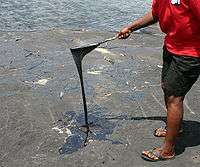Tar pit
A tar pit, or more accurately an asphalt pit or asphalt lake, is the result of a type of petroleum seep where subterranean bitumen leaks to the surface creating a large area of natural asphalt.[1] This happens because, after the material reaches the surface, its lighter components vaporize leaving only the thick asphalt.[2]

Notable tar pits
Major tar pits include Binagadi asphalt lake, the La Brea Tar Pits, the Carpinteria Tar Pits, the McKittrick Tar Pits, Pitch Lake, and Lake Bermudez.
Paleontological significance
Animals usually cannot escape from the asphalt when they fall in, making these pits excellent places to excavate bones of prehistoric animals. The tar pits can trap animals because the asphalt that seeps up from underground forms a bitumen pit so thick that even mammoths could not free themselves before they died of starvation, exhaustion from trying to escape, or exposure to the sun's heat. Over a million fossils have been found in tar pits around the globe.[2]
For other rich deposits, fossilized where they occurred, see Lagerstätten.
Living organisms
Living bacteria have been found in the La Brea Tar Pits. These organisms have been shown to be strains of previously discovered bacteria. They have been able to survive and thrive in an environment with little water and little to no oxygen. Scientists started looking for the bacteria when they noticed bubbles of methane coming out of the tar pits.[3]
Other microorganisms have been found living in microliter-sized droplets of water recovered from Pitch Lake in Trinidad, including bacteria from the orders Burkholderiales and Enterobacteriales.[4]
Helaeomyia petrolei, the petroleum fly, spends its larval stage within the tar pit.
References
- "A gravity investigation of the Pitch Lake of Trinidad and Tobago". Geological Society of Trinidad and Tobago. Archived from the original on January 31, 2010. Retrieved August 28, 2010.
- Perkins, Sid. "South America's sticky tar pits". Science News For Kids. Retrieved May 5, 2012.
- "Bubble, bubble, oil and...bacteria!". Science Buzz. May 31, 2007. Retrieved May 4, 2012.
- Madhusoodanan, Jyoti (August 8, 2014). "Microbes in a Tar Pit". The Scientist. Retrieved August 14, 2014.